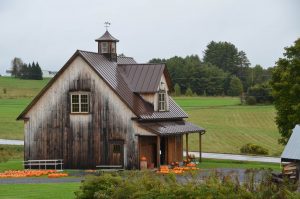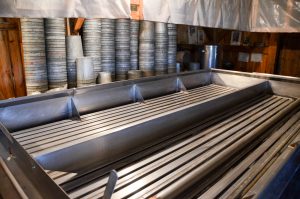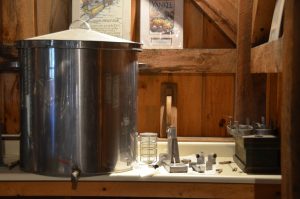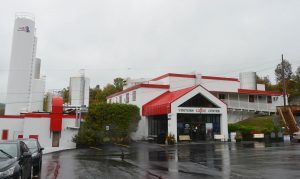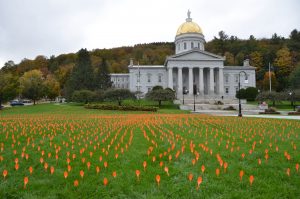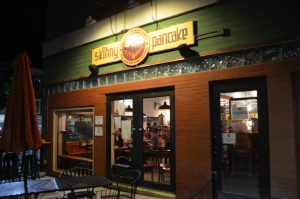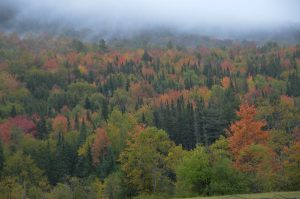We belong to an RV club called Harvest Hosts, which for $40/year supplies us a list of farms, wineries, and other places that offer free overnight parking for RV’ers. Until now, we’d only used it once, at Windmill Farm in California. When I saw there were a couple of sugar farm hosts in Vermont, it seemed like a perfect place to go in the fall. They were both near Montpelier, in Northern Vermont, and we chose the smaller of the two: Bragg Farm. They were happy to offer us space behind their store, up on a grassy hill, with a great view of mountains, the family farmhouse, and ponies and goats.
It was raining when we arrived and continued to rain heavily through the night and most of the next day. We had planned to drive to Maine, but because of the weather, decided to stay put another night. The Braggs were happy to accommodate us and suggested a rainy day trip to nearby Cabot for a tour of the cheese-making factory.
Bragg’s Sugar Farm
A Vermont sugar farm processes maple syrup, and this particular farm uses the age-old method of spouts and buckets, cooking the sap for days in a fire-fueled vat. Doug Bragg owns the farm, which includes the syrup-making equipment, a barn with sleighs, a large store, and farmhouse. He is the eighth generation in his family of sugar farmers, and his parents still live in the farmhouse behind the store.
Doug and his employees were so welcoming of us, and they set up a video for us to watch about the syrup-making process. Unlike newer farms that use tubes to collect sap in a central location, Bragg’s Farm still hangs tin buckets from taps. Collection begins in late winter, when the weather warms enough for the sap to flow, and continues into the spring. Every day the “gathering crew” collects sap from the buckets and brings it to the “sugar house.” If roads are impassable, they use horses and a sleigh to go out into the maple groves.
The sap is collected in large barrels and brought to the “sugar house” for cooking. Hundreds of gallons of the sap are poured into a large stainless steel tub, called an evaporator, which is heated continuously by a wood fire. It takes days for the sap to boil down to a smooth, rich syrup. One full barrel of sap (40 gallons) produces a single gallon of syrup.
When the syrup is ready, it’s drained into stainless steel barrels. The syrup is filtered, tested, and graded (Vermont has strict standards for its maple products), then bottled and canned for retail sales.
Syrup making is finished by late spring, and the rest of the year, the family runs the store, which is quite busy year-round. Each morning, Doug is busy “canning” enough syrup to keep up with sales.
Cabot’s Creamery
Visiting the Cabot Cheese factory was a great suggestion. This creamery is in a tiny town (Cabot) in the hills, and the drive there was gorgeous. The rain had turned soft, brightening the colors in the turning trees. Cabot’s Creamery is set up for tourists, with an endless supply of cheese samples and good prices on dairy products. We paid $3 apiece for the tour, which started with a movie about both the history of Cabot’s and the cheese-making process.
We were surprised to find out that Cabot’s is actually a co-op of farmers. It started in 1919, when local dairy farmers pitched in $5 a cow to purchase cheese-making equipment. The co-op now includes 1,200 farms and distributes their dairy products all over the country. New England dairy farmers are very proud to be collective owners of their own creamery.
In one day, this particular creamery takes delivery of one million gallons of milk and produces 100,000 pounds of cheese and other dairy products. When milk arrives from a farm, it is first tested in the laboratory for antibiotics or other contaminants. Even a trace of antibiotics requires rejection of the entire truck. (This normally happens once a year or less.) The milk is pumped into the giant stainless steel milk silos where it is immediately siphoned into the creamery for processing. First, the milk is stirred until it separates into cheese curds, whey, and water. The whey byproduct is sold as a protein source to makers of energy bars and protein powders. The water is reused for cooling purposed in the plant. The curds are stirred until smooth and mixed with any flavoring (such as peppers or rosemary) pressed into 42-blocks of cheese, which are then packaged and stored for curing – anywhere from 60 days to six years. This process takes just four hours.
Why is some cheese yellow? Early American colonists added yellow coloring to their cheese to make it easily distinguishable from Britain’s cheese. Later, New England stopped adding the coloring, but the South and the West preferred their cheddar cheese yellow. So about once a week, Cabot’s adds yellow coloring from the Lipstick tree in South America, for cheese that will be shipped out of New England.
Movie in Montpelier
Montpelier is a beautiful little town in the Vermont hills. It’s the state’s capital – the smallest capital city in the country. Only 7,000 residents. But the government buildings make it look larger, as do the legislators, who were in session now. It’s a town full of steeples and proud brick buildings, Victorian gables, and cozy pubs.
I think we’ve only gone to a movie once this trip, and when we saw that Grandma (Lily Tomlin) was playing, we decided to make a rainy night of it. We went in early enough to walk around the town, and we got to the Capitol just as people were dismantling a Hunger Awareness exhibit. The Capitol lawn was covered in a sea of orange plastic spoon, and each spoon represented 1,000 people on food assistance in Vermont. Signs noted that one in four Vermonters struggles with hunger.
The movie theater was one of those small avant guarde ones with couches and comfy arm chairs. We brought in burritos from the place next door, and Kate got a glass of wine. The theater only held 40 people, and I swear every one of them were friends. People our age, in corduroy and flannel. Our kind of people, and as they greeting each other and chatted, I missed being in a place where people call your name across a room.
The movie was wonderful, and afterwards we stopped in a little café where a bluegrass quartet was playing their last set. We ordered a dessert crepe and tea, and again the place was filled with people whose energy resonated with ours. Warm and down to earth, smart but unpretentious. As we walked back to the car, we agreed that this was a place we could see ourselves living – if it weren’t for the cold, harsh winters.
Fall Color
The next day we drove north and west, through Vermont and New Hampshire, to get to Maine. The fall leaves were still not near their peak, but there were pockets of brilliance that made the drive exhilarating. Kate drove and I snapped a few shots through the windshield, but I was only able to capture an idea of what it was like.

